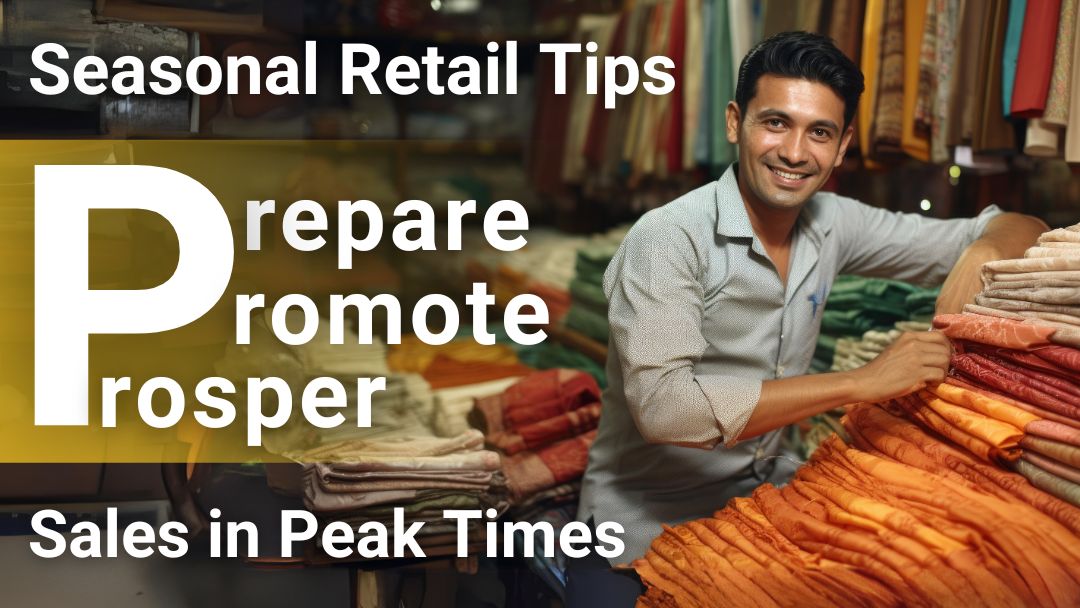WHAT IS PEAK SHOPPING SEASON?
Peak shopping season refers to the time of year when consumer spending and retail sales reach their highest levels. This period is typically characterized by a surge in shopping activities, as people make purchases for holidays and special occasions. The primary peak shopping seasons occur around major holidays such as Diwali, Eid, Holi, Christmas, Thanksgiving, New Year, Halloween, etc. During these times, retailers often offer significant discounts, promotions, and deals to attract customers and capitalize on the increased consumer demand.
Effect of Peak Shopping Season on Retail Business
The peak shopping season has a significant effect on retail businesses. Here are some of the effects:
1. Increased sales:
Retail businesses experience a surge in sales during the peak shopping season. Consumers are actively purchasing gifts, decorations, and other products, resulting in a higher volume of transactions. This can significantly boost revenue for retail businesses.
2. Higher foot traffic:
As more people go out to shop during this time, retail businesses see a significant increase in foot traffic. Shopping malls, stores, and online shopping platforms witness a larger number of customers, leading to a higher chance of increased sales.
3. Inventory management challenges:
The peak shopping season can pose challenges for retailers in managing their inventories effectively. With increased demand, retailers must ensure they have sufficient stock to meet customer needs without overstocking, which can lead to excess inventory and potential losses.
4. Need for temporary staff:
To handle the influx of customers, retail businesses often need to hire temporary staff during the peak shopping season. This includes cashiers, sales associates, customer service representatives, and warehouse personnel. It can be a logistical challenge for businesses to recruit, train, and manage these temporary employees effectively.
5. Intense competition:
Due to the increased consumer demand, the peak shopping season can be highly competitive for retailers. Businesses have to come up with compelling promotions and discounts to attract customers amidst a crowded marketplace. Sustaining customer loyalty and standing out from the competition becomes crucial during this time.
6. Online shopping growth:
With the rise of e-commerce, the peak shopping season has witnessed a significant shift towards online shopping. Retail businesses need to have strong online platforms and marketing strategies to cater to the growing number of customers preferring to shop online. This includes optimizing their websites and mobile apps, ensuring efficient delivery systems, and providing a seamless digital shopping experience.
7. Increased returns and exchanges:
Due to the high volume of purchases during the peak shopping season, retailers often experience an increase in returns and exchanges. Customers may change their minds about their purchases or encounter issues with the products, leading to an influx of returns. Retail businesses need to have robust return policies and efficient processes in place to handle these returns effectively.
Overall, the peak shopping season can be both an exciting and challenging time for retail businesses. It presents significant opportunities for increased sales but also requires careful planning, inventory management, and customer service to ensure success during this busy period.
Tips for Retailers to Prepare for Peak Season
1. Start Planning Early: Retailers should start the planning process well in advance to ensure they are prepared for the increased demand during peak shopping seasons. This includes analyzing the previous year’s data, predicting trends, and making inventory and staffing decisions accordingly.
2. Optimize Inventory Management: Having the right amount of inventory is crucial during peak shopping seasons. Retailers should analyze sales data and customer trends to determine which products are likely to sell well and stock up on them. Additionally, they should establish relationships with suppliers to ensure timely and consistent delivery of products.
3. Implement Effective Marketing Strategies: Retailers should develop targeted marketing campaigns to attract customers during peak shopping seasons. This can include offering special promotions, discounts, and exclusive deals. Social media, email marketing, and advertisements are important tools to reach and engage with customers.
4. Enhance Customer Experience: During peak shopping seasons, providing exceptional customer service becomes even more important. Retailers should ensure that their staff is adequately trained and prepared to handle the increased footfall. It is essential to have knowledgeable staff available to answer customer queries and facilitate smooth and efficient checkouts.
5. Optimize Online Presence: With the rise of e-commerce, retailers should focus on enhancing their online presence. This includes optimizing their website for a seamless user experience, improving search engine optimization, and ensuring fast and secure online transactions. Retailers should also consider investing in omnichannel strategies to provide a seamless shopping experience across different platforms.
6. Leverage Technology: Technology can play a crucial role in helping retailers capitalize on peak shopping seasons. Retailers should explore advanced analytics tools to gain insights into customer behavior and preferences. Additionally, they should consider leveraging artificial intelligence and machine learning tools to personalize the shopping experience for customers.
7. Plan for Increased Fulfillment and Logistics: Retailers should have a robust fulfillment and logistics plan in place to handle the increased volume of orders during peak shopping seasons. This can include partnering with third-party logistics providers, optimizing warehouse and distribution processes, and implementing efficient order-tracking systems to ensure timely delivery.
8. Optimize Your Store Layout: Prepare your store for increased foot traffic by rearranging displays and creating clear paths for customers. Make sure key products are prominently displayed and easily accessible. Consider placing impulse items near the checkout area to boost sales.
9. Monitor and Respond in Real-Time: It is essential for retailers to keep a close eye on sales and inventory levels during the peak shopping season. By monitoring sales data in real time, retailers can identify trends, adjust pricing, restock popular items, and make strategic decisions to maximize sales.
10. Foster Customer Loyalty: Peak shopping seasons provide an opportunity for retailers to build long-term customer relationships. Retailers should focus on personalized marketing, loyalty programs, and incentives to encourage repeat purchases and foster customer loyalty.
11. Analyze Performance and Learn: After the peak shopping season, retailers should analyze their performance and gather insights. This can help identify areas of improvement, understand customer preferences, and plan for future peak shopping seasons. By continuously learning from previous experiences, retailers can refine their strategies and stay ahead of the competition.
By following these tips, retailers can better prepare and capitalize on the opportunities presented during peak seasons, ultimately ensuring a successful and profitable period for their business.
SUMMING UP
Peak shopping seasons offer significant opportunities for retailers to boost sales and profitability. However, in order to fully capitalize on these peak shopping seasons, retailers need to adequately prepare.
One key aspect of preparation is optimizing inventory management. Retailers should analyze historical data and use predictive analytics to identify which products are likely to be in high demand during peak seasons. Another crucial aspect of preparation is creating a seamless and personalized shopping experience for customers. Lastly, creating eye-catching campaigns and prioritizing customer support can enable retailers to succeed in the peak shopping season.

